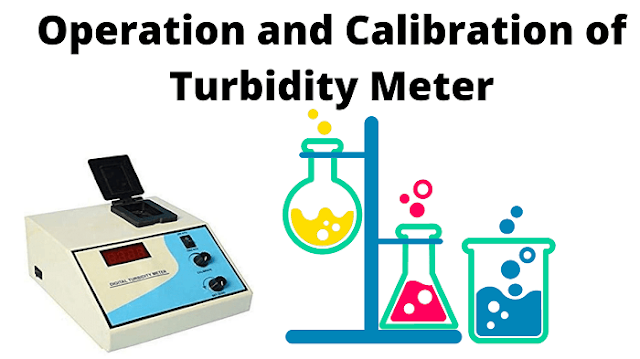What:- This document details the procedure for the Operation and Calibration of Turbidity Meter CL-52D (Naphalometer) - Elico.
Why:- It is the policy of Xyz Pharmaceuticals Limited that a written procedure shall be followed for the Operation and Calibration of Turbidity Meter CL-52D (Naphalometer) - Elico and its use monitored to ensure smooth operation and its use monitored to obtain consistent and reproducible results and to minimize downtime and to meet regulatory requirements.
When:- This procedure is to be applied at the time of Operation and Calibration of Turbidity Meter CL-52D (Naphalometer) - Elico.
RESPONSIBILITY
Persons along with their responsibilities and accountability are
given below:
To prepare the SOP. To maintain the records as
per SOP
To follow the SOP accordingly
Operation and Calibration of Turbidity Meter
5.1 PRELIMINARY CHECK
5.1.1 Check if the instrument is clean and free from dust, if not; clean it with a soft cloth duster.
5.1.2 Ensure that the temperature is about ambient and relative humidity is about 45%.
5.2 PRECAUTIONS
5.2.1 Allow the turbid meter
to warm up for at least 15 minutes prior to use.
5.2.2 Always use clean glassware and handle
cuvettes so there are no fingerprints in the area where light passes through
the sample.
5.2.3 Use alcohol and a lint-free cloth to clean
the outside of the cuvettes.
5.2.4 Once the cuvette becomes scratched or
pitted, replace it with a new cuvette.
5.2.5 Rinse the cuvette with about 0.5 ml of the
standard to be used. Discard. Repeat with a second rinse to ensure
that only the standard is present in the cuvette.
5.2.6 Store
the stock solution in a refrigerator at 4º C
5.2.7 Do not pour the used primary standard back into
the bottle. This contaminates the contents.
5.2.8 Allow the standard to reach room temperature
before using it to alleviate fogging of the cuvette.
5.2.9 If problems are encountered with taking a reading, allow the sample to sit loosely capped with a clean cap until all air bubbles have settled out or gently tap the sides of the cuvette to release air bubbles, and then take another reading.
5.3 OPERATION
5.3.1 Connect the plug to the main power supply and to the main switch of the instrument. Allow the turbid meter to warm up for at least 15 minutes.
5.3.2 To select the appropriate range Press the button push-out condition for 0-100 NTU and push-in condition for 100-1000 NTU given below side of the instrument.
5.3.3 Put the blank (Milli Q water filtered through 0.45µm membrane) into the sample holder and set the zero by zero setting knob.
5.3.4 Put
the 100NTU turbidity solution into the sample holder and set 100NTU by the 100
setting knob.
5.3.5 Now put the unknown sample into the sample holder and note the reading.
5.3.6 Switch off the instrument when not in use.
5.3.7 Maintain the Logbook of Turbidity Meter on XYZ/CQA/SOP-074/FR-01 Logbook for Turbidity Meter Appendix I.
6.0 CALIBRATION PROCEDURE
Turbidity meter calibration solution
6.0.2.1 Preparation of stock standard turbidity solutions:
Solution (1):
Take 1.0gm of Hydrazine sulfate into a 100 ml volumetric flask and make up the volume with turbid-free water.
Solution
(2):
Take 10.0 gm of Hexamethylenetetramine into the 100 ml volumetric flask and make up the volume with turbid-free water.
Stock 400 NTU solutions (3):
Pipette out 5.0ml stock solution (1) and 5.0ml stock solution (2) into the 100ml volumetric flask and stand for 24 hr at 25±2º C then fill up to the mark.
6.0.2.2 Preparation of intermediate standard solution:
40 NTU solutions (4):
Pipette 10.0ml of solution (4) into 100 ml volumetric flask and make up the volume up to the mark with turbid-free water.
6.0.2.3 Preparation
of working standard solutions:
2 NTU Solution:
Pipette
5.0ml of solution (4) into 100 ml volumetric flask and make up the volume up to
the mark with turbid-free water.
4 NTU Solution:
Pipette
10.0ml of solution (4) into a 100 ml volumetric flask and make up the volume to the mark with turbid-free water.
6 NTU Solution:
Pipette
15.0ml of solution (4) into a 100ml volumetric flask and make up the volume to the mark with turbid-free water.
8 NTU Solution:
Pipette 20.0ml of solution (4) into a 100 ml volumetric flask and make up the volume to the mark with turbid-free water.
10 NTU Solution:
Pipette 25.0ml of solution (4) into a 100 ml volumetric flask and make up the volume to the mark with turbid-free water.
Acceptance criteria
The linearity coefficient ‘r’ obtained from the linearity graph of Hydrazine sulfate and Hexamethylenetetramine for different levels should not be less than 0.999.
6.0.2.2 Discard the working turbidity solution after the calibration/verification.
6.0.2.3 Record the calibration data as per XYZ/CQA/SOP-074/FR-02 Appendix II
6.0.3 DAILY VERIFICATION OF TURBIDITY METER:
6.0.3.1 For the verification, determine the turbidity of the following standard solutions by following the same procedure as specified under basic operation. The verification is to be done on a daily basis before using the instrument.
6.0.3.2 Record the verification data as per XYZ/CQA/SOP-074/FR-03, Appendix III
6.0.3.3 Report
any discrepancy observed during the operation and calibration of the instrument to
Section
In charge of his representative for corrective and preventative action as per SOP No. XYZ/CQA/SOP-030, CAPA.
6.0.3.4 Section In-charge or his representative will take the necessary action and report the same to Manager-Quality Assurance.
6.0.3.5 Affix the “Out of Order” label on the instrument as per SOP No. XYZ/CQA/SOP-006, Labelling Policy.
7.0 GENERATION OF INSTRUMENT CALIBRATION
NUMBER
Generate the instrument calibration number on the calibration datasheet as INSCALXXYYZZZ where INS denotes instrument, CAL denotes calibration, XX denotes the year, YY denotes month and ZZZ denotes sequence number.
8.0 ABBREVIATION
XYZ Xyz Pharmaceuticals Limited
SOP Standard Operating Procedure
QC Quality Control
CQA Corporate Quality Assurance
LogBook and Appendix:- Download

